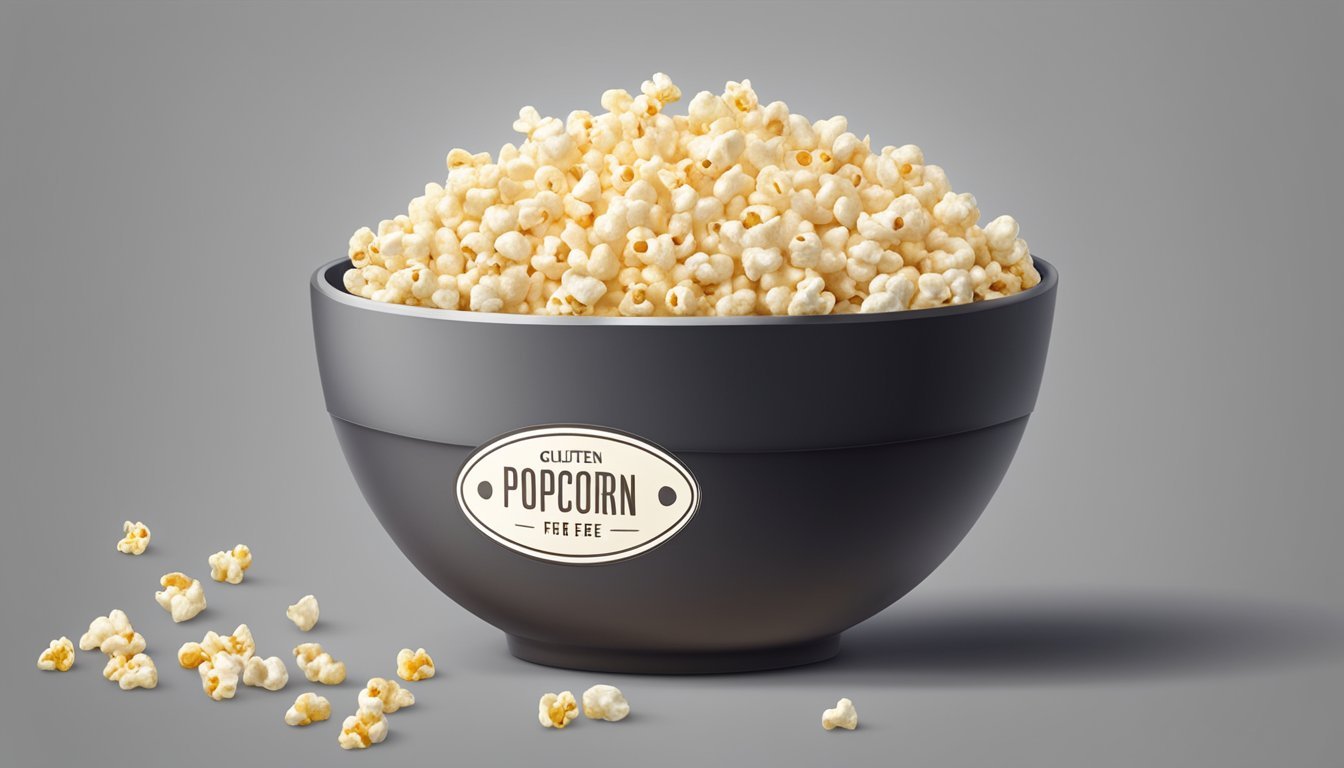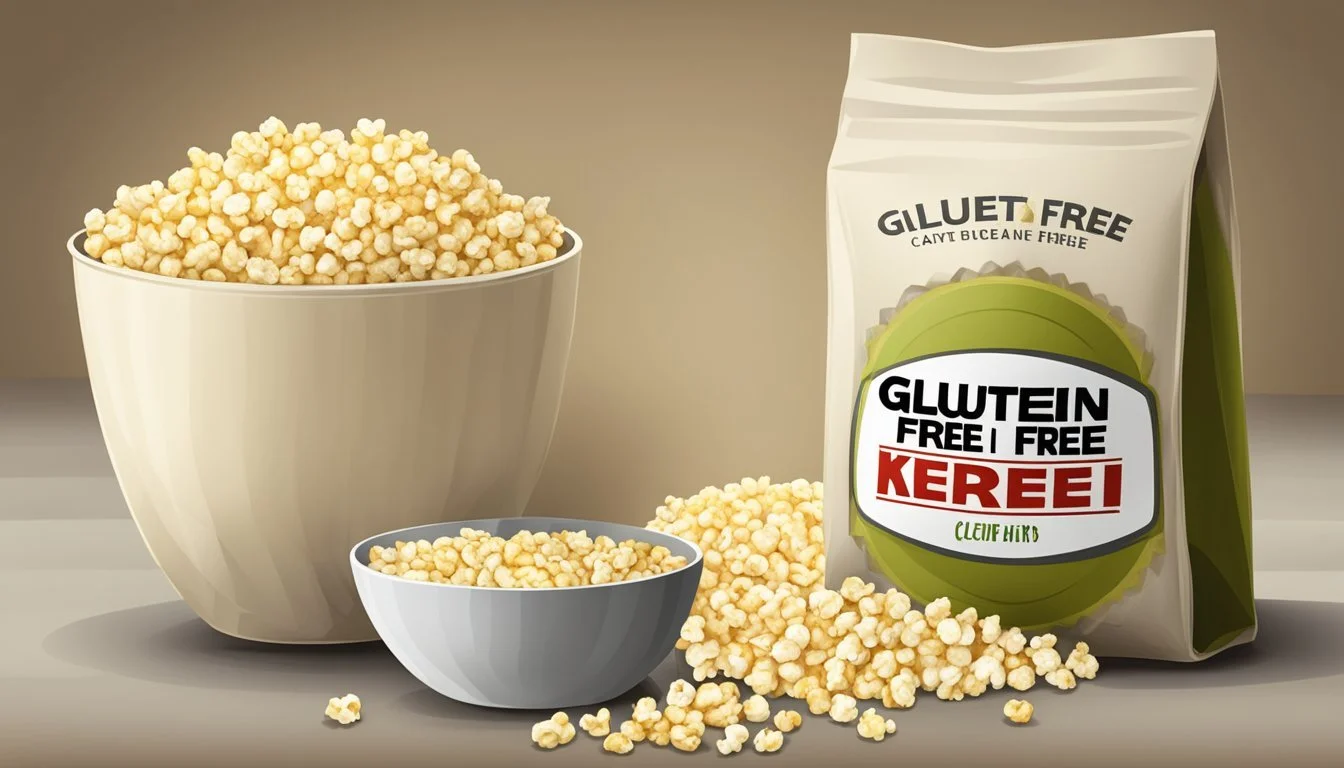Are Popcorn Kernels Gluten-Free?
Understanding Their Dietary Profile
Popcorn kernels are naturally gluten-free because they come from corn, a gluten-free grain. This makes popcorn a suitable snack for most people with gluten sensitivities or celiac disease. The primary concern for those looking for gluten-free options is cross-contamination or the addition of flavorings that contain gluten.
While most popcorn, especially when it is air-popped or cooked in oil with no additional ingredients, is safe for a gluten-free diet, consumers should be cautious. Gluten can find its way into popcorn products through toppings, seasonings, or processing methods used in manufacturing. Therefore, it's essential to check labels or contact manufacturers if the popcorn is pre-packaged or flavored.
Understanding Gluten
Gluten is a protein complex found in several types of grains, and it can trigger health issues in individuals with gluten-related disorders.
What Is Gluten?
Gluten is a protein found primarily in wheat, barley, and rye. It serves as a glue that holds foods together and provides elasticity. Gluten is commonly found in bread, pasta, cereals, and many processed foods.
Celiac Disease and Gluten Sensitivities
Celiac disease is an autoimmune disorder where the ingestion of gluten leads to damage in the small intestine. Symptoms can range from gastrointestinal discomfort to malnutrition and weight loss. A wheat allergy is another condition, which triggers an allergic response to wheat proteins, specifically.
For those with non-celiac gluten sensitivity, also known as gluten intolerance, consuming gluten can result in symptoms similar to celiac disease, such as bloating and abdominal pain, but without the intestinal damage. Gluten sensitivities are still not fully understood by science, and diagnosis can be challenging.
Popcorn Fundamentals
Exploring the basics of popcorn, this section uncovers what this popular snack is and addresses the common question of its gluten content.
What Is Popcorn?
Popcorn is a variety of corn kernel which expands and puffs up when heated. The kernel's strong hull contains the seed's hard, starchy endosperm with 14-20% moisture, which turns to steam as the kernel is heated. When the hull's resistance is overcome by the pressure, popcorn erupts into the fluffy, white snack people know and love.
Is Popcorn Naturally Gluten-Free?
By nature, popcorn is gluten-free. This means that, fundamentally, popcorn should not contain gluten, which is a group of proteins found in wheat, barley, and rye. Since popcorn comes from corn, which does not possess these proteins, it stands as a naturally gluten-free food. However, cross-contamination with gluten-containing substances during processing or flavoring can occur, so it's crucial for those with gluten sensitivities to verify the popcorn's purity by checking product labels and certifications.
Potential Sources of Gluten in Popcorn
While popcorn kernels are inherently gluten-free, there are several factors during processing and preparation that may introduce gluten into the final product. These factors include cross-contamination risks, gluten-containing seasonings and additives, plus considerations related to butter and oils.
Cross-Contamination Risks
Farming: Gluten cross-contamination can begin in the fields if popcorn is grown near wheat, barley, or rye.
Manufacturing: Shared processing equipment is another potential source, where popcorn might be exposed to gluten from other food products.
Packing: Facilities that package both gluten-free and gluten-containing products pose a risk if strict measures are not in place to prevent mingling.
Preparation: When popcorn is prepared in environments that handle gluten, like kitchens or concession stands, cross-contamination is possible via utensils, surfaces, or machines.
Seasonings and Additives
Flavorings: Many flavorings and seasonings may contain gluten. Ingredients like malt flavoring and certain starches, which are derived from barley or wheat, can contaminate popcorn.
Pre-packaged Popcorn: Commercially packaged popcorn may include additives for taste that contain gluten, such as wheat starch or modified food starch from gluten sources.
Butter and Oil Considerations
Butter Flavors: Some butter flavorings used in popcorn may contain barley-based ingredients, leading to gluten presence.
Cooking Oil: Oils are typically gluten-free, but cross-contact with gluten-containing foods could contaminate them.
Consumers with gluten sensitivities or celiac disease should verify that popcorn products are not only made from gluten-free grains but also prepared and served in a manner that minimizes the risk of gluten exposure.
Reading Labels for Gluten Content
When selecting gluten-free popcorn, it is imperative that individuals carefully read and understand labels. Label scrutiny is crucial to avoid gluten contamination and ensure the popcorn meets the gluten-free standards.
Ingredients to Watch Out For
Identifying gluten ingredients on labels is essential for those with celiac disease or gluten sensitivity. Below is a list of ingredients often found in popcorn and related products that may contain gluten:
Wheat: This includes any form of wheat, including spelt, khorasan wheat (kamut), farro, durum, and wheatberries.
Barley: Look for malt, which is commonly made from barley, and can be found in flavorings and seasonings.
Rye: Less commonly found but still a potential source of gluten.
Oats: Although naturally gluten-free, oats can be contaminated with wheat during growing or processing unless specified as gluten-free.
Brewer's Yeast: This ingredient is sometimes used in flavorings and can be a byproduct of beer production, which usually contains gluten.
Understanding Gluten-Free Labels
Labels are a consumer's first line of defense in identifying whether popcorn is gluten-free. They should look for specific indications that confirm a product is safe:
Gluten-Free Statement: If a label has a "gluten-free" claim, it suggests the product contains less than 20 parts per million (ppm) of gluten, in compliance with U.S. Food and Drug Administration (FDA) regulations.
Certified Gluten-Free: Presence of a certification symbol from a gluten-free certification organization offers additional assurance that the product meets strict gluten-free standards. Such certifications often represent a lower threshold of gluten content than the FDA's requirement.
Ingredient List: The ingredient list should be reviewed for hidden gluten-containing additives or ingredients.
Consumers should also be mindful that cross-contamination during processing can affect the gluten-free status of a product. Therefore, even if the ingredients are gluten-free, it's important to verify that the final product is, too. If a label states that the popcorn is "Certified Gluten-Free," it indicates that steps have been taken to minimize the risk of cross-contamination, providing peace of mind for those with gluten-related disorders.
Safe Popcorn Options for a Gluten-Free Diet
When selecting popcorn for a gluten-free diet, consumers should consider brands known for gluten-free options, understand the purity of homemade popcorn, and ensure that store-bought kernels are labeled gluten-free.
Gluten-Free Popcorn Brands
Gluten-Free Brands:
Smartfood: Offers a variety of flavored popcorns, typically gluten-free.
Skinnygirl Popcorn: Marketed as a healthier option, also known for being gluten-free.
Black Jewell Popcorn: Less common, but noted for its unique black kernels and gluten-free status.
Great Northern Popcorn Company: Provides pure popcorn that is safe for gluten-free consumers.
Jolly Time: A brand that often accommodates gluten-free diets with specific products.
Homemade Popcorn Considerations
Homemade Popcorn:
Oil: Use high-quality oil that is gluten-free, such as olive or coconut oil.
Cross-Contamination: Be cautious to prevent cross-contamination with gluten-containing products, especially in shared cooking environments.
Choosing the Right Popcorn Kernels
Selecting Kernels:
Packaged Kernels: Confirm that the packaging on store-bought popcorn kernels indicates a gluten-free product.
Amplify Snack Brands, American Pop Corn Company: These companies often offer explicitly labeled gluten-free kernels suitable for those with celiac disease or gluten sensitivity.
Preparing Popcorn without Gluten
Preparing gluten-free popcorn involves selecting the right kernels and being mindful of the cooking method. It's essential to ensure that the popcorn is not exposed to any sources of gluten from farm to bowl.
Air-Popped Popcorn
Air-popping is one of the purest ways to prepare popcorn, as it requires no oil and typically uses standalone poppers or machines, thus reducing the risk of contamination. For gluten-free air-popped popcorn, one should:
Use certified gluten-free popcorn kernels.
Ensure the air-popper has not been used with gluten-containing products.
Stovetop Cooking Methods
When cooking popcorn on a stovetop, using a dedicated pot can minimize the chance of gluten cross-contact. Here, stovetop popping specifics are crucial:
Choose gluten-free kernels and gluten-free oils, such as coconut or olive oil.
Clean the pot thoroughly if it has been previously used to cook gluten-containing foods.
Microwave Tips and Tricks
Microwave popcorn can be convenient but warrants caution. While many microwaveable popcorns are gluten-free, some may contain additives or are processed in facilities that also handle gluten. To ensure gluten-free microwave popcorn:
Look for packets labeled gluten-free with less than 20 ppm of gluten, indicating safe consumption levels for those with celiac disease.
Avoid pre-flavored microwave bags, which can contain wheat flavors or malt, unless they're clearly labeled as gluten-free.
Popcorn as Part of a Healthy Diet
Popcorn, when prepared properly, can serve as a nutritious snack that aligns with a healthy diet. This whole grain snack boasts a range of nutritional benefits, is low in calories, and can be adapted through healthy alternatives to traditional popcorn.
Nutritional Benefits of Popcorn
Popcorn is a whole grain, making it a good source of dietary fiber, which is important for digestive health. It also contains antioxidants such as polyphenols, as well as vitamins and minerals like Vitamin B1, magnesium, and phosphorous. One of the benefits of eating popcorn is its satiety factor; it can help one feel full longer, which can aid in weight management.
Caloric Considerations
While popcorn itself is low in calories, the final caloric content depends heavily on preparation methods. Air-popped popcorn contains approximately 31 calories per cup, making it a low-calorie snack option. However, when butter, oil, sugar, or other toppings are added, the caloric value can increase significantly.
For example:
1 cup of air-popped popcorn: Approximately 31 calories
1 cup of oil-popped popcorn: Approximately 55 calories
1 cup of caramel-coated popcorn: Can exceed 150 calories
Alternatives to Traditional Popcorn
For those looking for alternatives to traditional popcorn, options such as popcorn chips and mini cakes are available. These products often retain the nutritional benefits of whole grain popcorn but may have different caloric contents and textures. Using an air popper for making popcorn at home can ensure no additional fats or unwanted additives are incorporated, preserving the snack's nutritional value.
Specialty Popcorn Varieties
When exploring specialty popcorn varieties, it is essential for consumers to be aware of the ingredients used in flavored and gourmet popcorn, as well as the oils and seasonings that can offer unique tastes but may affect gluten-free status.
Flavored and Gourmet Popcorn
For those who enjoy a more indulgent snack, gourmet popcorn options abound, often featuring a rich tapestry of flavors. Varieties like kettle corn combine sweet and salty notes, typically achieving this signature taste through a blend of sugar and salt. Gourmet selections may include chocolate or caramel coatings, both of which are generally gluten-free in their pure forms. However, care must be taken as artificial ingredients and spice blends may sometimes contain gluten as a hidden component. Those seeking gluten-free options should look for labels that verify this status, especially since cross-contamination can occur if the popcorn is processed in a facility that also handles wheat or other gluten-containing ingredients.
Flavored Popcorn Varieties:
Kettle Corn
Caramel
Chocolate
Cheese
Spicy: often with chili or pepper
Non-Traditional Oils and Seasonings
Specialty popcorn can also be found popped in non-traditional oils like avocado oil or coconut oil, both praised for their health benefits and unique flavor profiles. Avocado oil imparts a subtle, buttery flavor while coconut oil adds a hint of sweetness. These oils are naturally gluten-free, yet checking for cross-contamination remains crucial. Seasonings range from simple salt and buttery topping, which should be gluten-free, to complex proprietary spice blends that can occasionally include gluten-containing ingredients. It is incumbent upon manufacturers to disclose this on their packaging, but it remains the consumers' responsibility to conduct due diligence.
Non-Traditional Oils:
Avocado Oil
Coconut Oil
Other Specialty Oils
Common Seasonings:
Salt
Buttery Topping (note: may contain artificial ingredients)
Managing Risks of Gluten Exposure
When individuals with celiac disease or gluten sensitivity consume gluten, even in small amounts, it can lead to adverse health effects. Therefore, mitigating the risks of gluten exposure in popcorn kernels is crucial.
Cross-contamination is a significant concern, as it can occur during the growing, harvesting, processing, or packaging stages. To prevent this, manufacturers must follow strict protocols. Dedicated facilities and equipment are recommended to ensure that popcorn kernels remain gluten-free.
To quantify gluten presence, scientists measure in parts per million (ppm). The standard for labeling a product as gluten-free is 20 ppm or less, which is considered safe for most people with gluten-related disorders.
Consumers can look for gluten-free certification on packaging. This indicates that the product has undergone rigorous testing to meet stringent gluten-free standards. A third-party certification, such as the one provided by NSF, offers an additional layer of assurance as these organizations independently verify the product's gluten-free status.
Here is a quick reference guide for managing gluten exposure risks:
Read Labels Carefully: Look for clear gluten-free labeling and certification logos.
Ask Questions: When in public settings like movie theaters, inquire about the preparation process.
Avoid Shared Equipment: At home, use a dedicated air-popper or cooking method that hasn't been used for gluten-containing foods.
Being informed and vigilant helps individuals maintain a safe and enjoyable popcorn-eating experience free from gluten exposure risks.
Understanding Food Regulations
When it comes to containing gluten, food regulation entities play crucial roles in defining and monitoring gluten-free status for consumer safety and transparency.
What the FDA Says About Gluten-Free Foods
The U.S. Food and Drug Administration (FDA) stipulates that for a product to carry a "gluten-free" label, it must contain less than 20 parts per million (ppm) of gluten. This standard aims to protect consumers, especially those with celiac disease, who require stringent dietary management. Strict adherence ensures that products are safe for consumption by individuals who are sensitive to gluten.
Key FDA Criteria: Gluten levels must be under 20ppm
Labeling: Must accurately reflect the gluten content
Consumer Safety: Prioritizes individuals with gluten sensitivities
Role of Gluten-Free Certification Organizations
Gluten-Free Certification Organizations (GFCO) serve as third-party entities that provide additional assurance on food safety. They validate claims of gluten-free products through rigorous testing and compliance with set standards that may even exceed FDA requirements.
Certification:
Conducts independent testing of products
May require gluten levels to be below 10 ppm, stricter than the FDA's requirement.
Trustworthiness: Offers a seal of approval that helps consumers identify safe products confidently.
Standards: Ensures compliance with specific gluten-free product standards.
Both the FDA's regulations and third-party certifications help maintain a level of safety and transparency for gluten-free products.
Conclusion
Popcorn kernels, in their natural state, are gluten-free. These kernels originate from corn, a grain that does not contain gluten, making them an appropriate snack for individuals with celiac disease or gluten intolerance. However, consumers must exercise caution and be vigilant about cross-contamination risks which could occur during the processing, packaging, or preparation stages.
When selecting popcorn, one should prioritize products labeled as “gluten-free” or “certified gluten-free.” This labeling indicates that the popcorn has been tested for gluten and meets strict guidelines for gluten-free certification.
For those preparing popcorn at home, ensuring that all utensils and cooking surfaces are free of gluten residue is crucial. Air-popping popcorn at home is often the safest method to prevent exposure to gluten found in certain additives or flavorings of pre-packaged popcorn.
To summarize, while popcorn kernels are fundamentally free from gluten, the environment in which they are processed and prepared must be monitored closely to ensure a truly gluten-free product. Consumers should regularly review product labels and take necessary precautions to guarantee their popcorn remains a safe, gluten-free choice.










